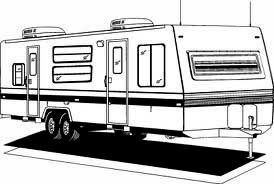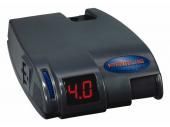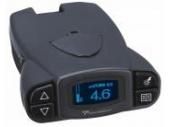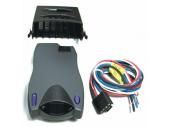Advanced Towing Electrical Solutions - Safe & Efficient
At Eyers Hitch Center Inc., we ensure your towing setup is robust and seamlessly integrated with your vehicle's electrical system. Our expert electrical services for towing and trailer hitches are designed to provide reliable and safe connections for all your towing needs. From tail lights to brake controllers, we ensure every electrical component is perfectly synced with your vehicle, guaranteeing a safe and legal towing experience every time. Trust us to light up your towing journey with expertise and precision. Call 408-248-4454 today!
Tail Light Converters
Brake Control Wiring
Brake Controllers
Wiring Diagram for Common Plugs
RVi3 Braking System
Breakaway Switches
Trailer Wiring & Brake Control Wiring
Special light and wiring systems must be installed on your tow vehicle before you can tow any trailer. The trailer lighting system must be separate from your tow vehicle lighting system. Our qualified hitch installer will wire your taillights, signals, and brake light functions into a special plug or connector to access the trailer's light systems.
Types of Light Wiring Systems
Most trailers are wired to use a single red light for the brake and turn signals (1 bulb per side). This is known as a 4-wire system. Most import vehicles and newer domestic vehicles have both a red brake signal and a separate amber turn signal (2 bulbs per side). This is a 5-wire system. Tail light converters are required to connect a vehicle with a 5-wire system to a trailer with a 4-wire system. Eyers Trailer Hitch Center sells and installs tail light converters and trailer light power modules to accomplish this.
Tail Light Converters
We are also seeing more sophisticated computer systems being installed on vehicles nowadays. In many cases, we must bypass the computer system when we wire a vehicle for towing so that the towing wiring is clear to the vehicle's computer. Something needs to be fixed with its lighting system.

Converters
All trailer light power is routed through the tow vehicle's light circuits.

Trailer Light Power Module
All trailer light power is routed directly from the tow vehicle's battery via a separate power line. Required for some vehicles to avoid vehicle light circuit damage.
Trying to DIY? Talk to Our Technicians
Again, special converter units and wiring harnesses must be installed to alleviate this problem. That can get expensive. If you are a do-it-yourself wire person, please ask us for advice before wiring. Improper wiring can lead to blown fuses and, in extreme cases, overheating of wires, which can result in a fire in your vehicle.
Lighting for Sophisticated Trailers
Wiring gets slightly more complicated when you tow larger or more sophisticated trailers. Instead of needing simple wiring to run lights only, some trailers require extra wiring to run electric brakes, 12-volt battery charge lines, backup lights, and refrigerator power. Your hitch installer can determine your wiring needs based on the trailer you are towing and what kind of tow vehicle you have.
Brake Control Wiring
If a trailer is longer than 15 feet or weighs more than 1500 lbs., by law, it must be equipped with a brake system.
Types of Trailer Brake Systems
There are two types of brake systems used today. Most boat or water sport trailers are equipped with hydraulic brakes, sometimes called surge brakes. The other type of brake system is electronically controlled electric brake control wiring.
These braking systems must conform to Federal, State, and Local regulations. The law states that if you tow a trailer equipped with electric brakes, you must have a brake control unit installed and working in your tow vehicle.

Pendulum Interia Braking Systems
Some of the older brake control units utilize a pendulum inertia type technology to achieve activation of trailer brakes. The problem with this type of system is that the box must be mounted exactly in only one position for the internal pendulum to properly activate the system. Sometimes, if you go up and down hills, the pendulum is fooled into activating the brakes improperly.
The newer technology utilizes an all-electronic solid-state system to activate the brakes. The brake control wiring box can be mounted in any position. They are relatively trouble-free.
Wiring Diagram for Common Plugs
Here's a handy Wire Diagram for the most common types of electrical plug connectors:
RVi3 Braking System
Nowadays, most states and Canada require you to have a braking system installed on your towed vehicle. Canada will only let you in if you have one! We love the RVi3 Braking system, which easily sets up and transfers to any other vehicle. It comes with a tablet-controlled monitor for the coach and breakaway system.
RVi Brake 3 Braking System
For towed vehicles behind a motorhome.
Towed Battery Charger
Breakaway Switches
A breakaway switch uses a sizeable dry cell battery or the auxiliary 12-volt battery within the trailer to automatically engage the brakes if the trailer is accidentally detached from the tow vehicle. The pin is inserted in the breakaway switch to hold the switch open. If the trailer becomes detached, the cable will pull the pin from the switch, and the switch will then apply electrical current to the trailer brakes. You should occasionally check the breakaway switch by pulling the pin out and checking the braking action.
Testing the Breakaway Switch
You can test the breakaway switch before each trip as follows:
- Hitch the trailer to the tow vehicle.
- Pull out the breakaway switch-actuating pin.
- Test brakes by attempting to drive away. The breakaway switch is functioning correctly if the trailer brakes are activated. (Brakes will be locked up.)
- If the brakes are not activated, check that the trailer battery is connected and fully charged and the brakes are correctly adjusted.
- Obtain service repair if the trailer brakes do not operate after making these checks.
- Reinsert the breakaway switch-actuating pin before towing the trailer.
Note: Never use the breakaway switch as a parking brake when parked on a hill. The battery will run down, and the breakaway system will not function properly when needed.
For all your towing electrical needs, call us at 408-248-4454 or come to our shop for a solution!








